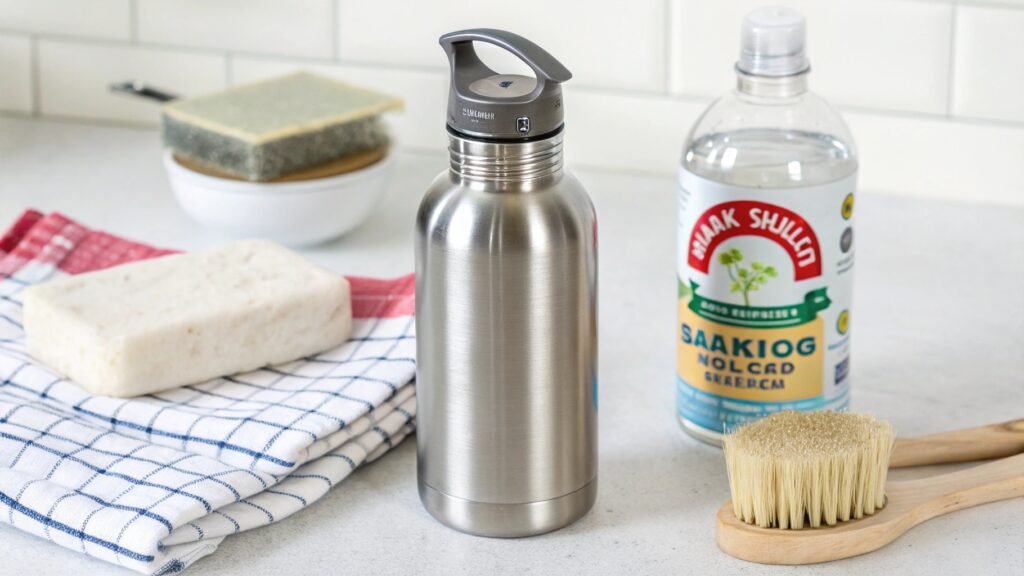Is Your Stainless Steel Water Bottle Truly Clean?
Ever wonder if your stainless steel water bottle is as clean as you think? It's easy to overlook proper cleaning, but that can affect both your bottle's lifespan and your health. What if you could ensure every sip was perfectly fresh and safe?
Keeping your stainless steel water bottle truly clean means more than just a quick rinse; it involves using the right cleaning agents like mild soap, white vinegar, or baking soda, paying attention to all parts, especially the lid, and cleaning it regularly to prevent bacterial growth and maintain water quality and taste.

I've learned that small habits, like proper bottle cleaning, can make a big difference in daily well-being. It's not just about what you drink, but also what you drink from.
How Do You Clean the Inside of a Stainless Steel Water Bottle?
Do you struggle to get the inside of your stainless steel water bottle1 sparkling clean? It can be tough to reach every corner, and lingering odors or buildup are frustrating. So, what is the most effective way to clean the inside thoroughly?
To clean the inside of a stainless steel water bottle effectively, use warm water with mild dish soap and a bottle brush for daily cleaning. For stubborn odors or mineral buildup, use natural solutions like white vinegar or baking soda, letting them soak before rinsing thoroughly to ensure a fresh, clean interior.

I've found that a little effort in cleaning goes a long way. It is not just about hygiene; it is about enjoying your water more.
What is the basic method for daily cleaning of the bottle interior?
For daily cleaning, the most basic and effective method for the inside of your stainless steel water bottle involves warm water and mild dish soap. Avoid harsh detergents or very hot water, as these can potentially damage the stainless steel surface or seals over time. Start by rinsing the bottle with warm water. Then, add a few drops of mild dish soap. Fill the bottle partially with warm water. Use a long-handled bottle brush to scrub the entire interior thoroughly, making sure to reach the bottom and sides. This brush is crucial for physical removal of residue. After scrubbing, empty the soapy water. Rinse the bottle multiple times with clean, warm water until there are no soap suds left. This simple routine helps remove daily grime and prevents buildup. I make sure to do this every evening after using my bottle. It keeps it ready for the next day.
How can you remove stubborn odors or flavors from the bottle?
If your bottle has developed stubborn odors or residual flavors, natural cleaning agents2 like white vinegar or baking soda are highly effective. For odors, mix about 1/4 cup of white vinegar with warm water. Pour this mixture into the bottle. Cap it. Shake it vigorously for a few minutes. Let it sit for about 30 minutes to an hour, or even overnight for strong odors. White vinegar is excellent for natural disinfection and odor neutralization. After soaking, pour out the vinegar solution. Rinse the bottle thoroughly multiple times with clean water until the vinegar smell is gone. For lingering coffee or tea stains, or general mineral buildup, a paste of baking soda and a little water can work wonders. Apply the paste inside, let it sit, then scrub with your bottle brush and rinse well. I have found this method works magic on my coffee thermos. It always comes out smelling fresh.
What about cleaning the bottle cap and seal?
Cleaning the bottle cap and any removable seals is just as important as cleaning the bottle interior, as these areas can harbor bacteria and mold. Many bottle caps have crevices and silicone rings that trap moisture and residue. For most caps, you can disassemble them if possible. Remove any silicone gaskets or rings. Wash all parts separately with warm water and mild dish soap, using a small brush or even a cotton swab to get into tight spots. Pay special attention to the threads of the cap and the drinking spout. For silicone seals, a soak in a solution of white vinegar and warm water can help remove any stubborn grime or mold. Always ensure all parts are thoroughly rinsed and air-dried completely before reassembling. This prevents mold or mildew growth. I often let my cap and seal dry on a drying rack overnight. This ensures no moisture is trapped.
What Happens if You Don't Clean Your Stainless Steel Water Bottle?
Ever skipped a wash for your water bottle, thinking it's just water? It might seem harmless, but neglecting to clean your stainless steel water bottle can lead to some unpleasant and even unhealthy consequences. So, what truly happens when you do not clean it regularly?
If you don't clean your stainless steel water bottle regularly, it can become a breeding ground for bacteria, mold, and mildew, leading to unpleasant odors, a bad taste in your water, and potentially causing health issues3. Mineral deposits can also build up, affecting the bottle's hygiene and overall lifespan.

I have learned that cleanliness is not just about appearances. It is about protecting yourself from unseen dangers that lurk in neglected items.
How does bacteria and mold growth affect your water bottle?
Leaving your stainless steel water bottle uncleaned turns it into a prime environment for bacteria, mold, and mildew to grow. Even plain water can leave behind organic matter from your mouth. This acts as food for microorganisms. If you drink anything other than water, like coffee, tea, or juice, the sugar and other residues provide even more nutrients for growth. Over time, a biofilm can form on the inside surfaces. This layer is a slimy buildup of microorganisms. This can lead to a foul smell and an unpleasant taste in your water. This also means you are consuming these microorganisms every time you drink. While many might not be immediately harmful, some can cause digestive issues or other health problems. I have personally experienced the unpleasant taste of an uncleaned bottle. It is a definite deterrent from staying hydrated.
What are the long-term consequences for the bottle itself?
Beyond hygiene, neglecting to clean your stainless steel water bottle can also have negative long-term consequences for the bottle itself. Mineral deposits from tap water, especially in hard water areas, can build up on the inside surfaces. This forms a white, chalky residue. Over time, these deposits can become very difficult to remove. They might even affect the efficiency of the bottle's insulation if they accumulate significantly. Unchecked mold and mildew growth can also potentially damage the silicone seals or plastic parts of the lid, leading to leaks or impaired functionality. While stainless steel is generally resistant to rust, constant moisture and accumulated grime can sometimes lead to pitting or discoloration if left unaddressed for very long periods. A neglected bottle simply will not last as long.
Can not cleaning your bottle lead to health issues?
Yes, not cleaning your stainless steel water bottle can potentially lead to various health issues. The bacteria, mold, and yeast that thrive in a moist, uncleaned environment can be ingested with your water. While your immune system can handle small amounts of common bacteria, consistent exposure to these microorganisms can sometimes lead to gastrointestinal upset, nausea, or even more serious infections, especially for individuals with weakened immune systems. For example, if you are filling your bottle from various sources, you might introduce different types of bacteria that then multiply. The simple act of drinking from a dirty bottle means you are constantly re-exposing yourself to these germs. This is why regular and thorough cleaning is crucial. It protects your health. It ensures your hydration source is truly healthy.
How Often Should I Wash My Stainless Steel Water Bottle?
Ever wonder how frequently you should be cleaning your trusty stainless steel water bottle? It might seem like a chore, but regular cleaning is key for hygiene and freshness. So, what is the ideal cleaning schedule for your bottle?
You should wash your stainless steel water bottle after every single use, especially if you've put anything other than water in it. For water-only use, a thorough wash daily is ideal. Deep cleaning with vinegar or baking soda should be done weekly to prevent buildup and ensure optimal hygiene.

I've learned that a consistent cleaning routine, like brushing your teeth, keeps things fresh and problem-free in the long run.
Why is daily washing crucial, even for water-only use?
Even if you only fill your stainless steel water bottle with plain water, daily washing is crucial. Your mouth naturally contains bacteria. Every time you take a sip, some of these bacteria transfer to the bottle's rim and the water inside. While water itself doesn't "spoil," these transferred bacteria can multiply rapidly in the moist environment of the bottle. This can lead to a thin, invisible biofilm forming on the interior surfaces. This daily accumulation, even if not immediately noticeable, can eventually lead to odors or a slightly off-taste in your water. A quick rinse with soap and water after each day's use prevents this growth. It ensures your bottle is fresh and hygienic for the next day. I always give my bottle a quick wash every evening, just like I wash my dinner plate.
When should you perform a deep clean on your bottle?
While daily washing is essential, a deep clean should be performed at least once a week, or more frequently if you use your bottle for beverages other than water (like coffee, juice, or protein shakes). Beverages with sugar or dairy provide a richer environment for bacteria and mold to thrive. A deep clean involves using agents like white vinegar or baking soda to tackle stubborn odors, mineral deposits, or any nascent mold growth that daily washing might miss. This weekly deep clean helps break down and remove any accumulated film or residue. It ensures thorough sanitization. It restores the bottle to its pristine condition. This regular deep cleaning also helps extend the lifespan of your bottle. It keeps it free from buildup that could otherwise damage its interior.
What are the best practices for air drying and storage?
Proper air drying and storage are just as important as washing for maintaining your stainless steel water bottle's hygiene and integrity. After washing, it is critical to allow all parts of the bottle, including the cap and any removable seals, to air dry completely before reassembling or storing. Trapped moisture is the primary cause of mold and mildew growth, even in a "clean" bottle. Store the bottle uncapped and disassembled if possible, in a dry, well-ventilated area. Avoid putting a damp bottle directly into a cupboard or drawer, as this creates a stagnant, moist environment. This invites microbial growth. This also helps prevent any musty smells from developing. I always leave my bottle and cap on a dish rack overnight. This ensures they are fully dry before I put them away.
Conclusion
Cleaning your stainless steel water bottle properly means understanding how to wash it daily, deep clean weekly, and dry it completely. This simple routine protects your health, enhances your water's taste, and extends your bottle's life.





